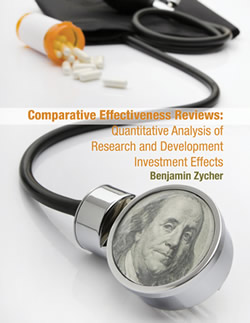A based free-market think tank, examines an expanded quasi-federal comparative effectiveness review (CER) process and the negative effects on private-sector investment in research and development of new and improved medical technologies.

San Francisco (July 15, 2011) — A new research study released by the Pacific Research Institute (PRI), a California-based free-market think tank, examines an expanded quasi-federal comparative effectiveness review (CER) process and the negative effects on private-sector investment in research and development of new and improved medical technologies. Under conservative assumptions, R&D investment in pharmaceuticals, medical devices and equipment would be reduced by about $10 billion per year over the period from 2014 through 2025. Comparative Effectiveness Reviews: Quantitative Analysis of Research and Development Investment Effects was authored by PRI senior policy fellow Benjamin Zycher, Ph.D.
Comparative Effectiveness Review (CER) is defined by the Congressional Budget Office as a rigorous evaluation of the impact of different options that are available for treating a given medical condition for a particular set of patients. Because policymakers have powerful incentives to restrain the growth of health care expenditures, an expanded federal role in CER, whether direct or indirect, will induce responses from the private sector as a result of expectations of how CER findings will be used by policymakers. For firms investing in and developing medical technologies, these expectations include an increased need for private clinical testing, increased pricing pressures, increased risk of non-approval or limited approval for federally-financed programs, a shortening of the patent period and delays in expected sales revenues.
Using data from the National Science Foundation and other sources, the report concludes that under conservative assumptions, R&D investment in new and improved pharmaceuticals and medical devices and equipment would be reduced by about 10-12 percent. This reduction in the flow of new and improved technology would impose an expected loss of about 5 million life-years annually, with a conservative economic value of $500 billion an amount substantially greater than the entire U.S. market for pharmaceuticals, devices and equipment.
The effects of reduced investment in R&D would not apply uniformly to the U.S. population; instead, it would be concentrated upon particular population subgroups the identity of which depends upon how the adverse R&D effects are implemented over time. This reduced investment in medical R&D would be likely to affect technologies serving smaller populations, riskier treatments and drugs expected to prove relatively less profitable.
Dr. Zycher concludes, These findings suggest that an expanded CER process at the federal level may be very unwise in a policy context, and that a renewed emphasis upon a bottoms-up approach of experimentation by many millions of practitioners and patients would be a more fruitful vehicle for the acquisition of information about the comparative effectiveness of alternative clinical approaches.
